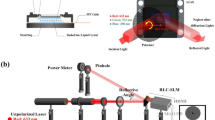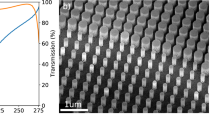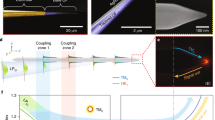Abstract
Lenses for precision electron optics are mainly magnetic, requiring large cylinders of soft iron to focus an electron beam. Such lenses can only be convergent1, and so suffer from spherical aberration. Electrostatic lenses are sometimes used, but tend to be even more cumbersome. The advent of high-brightness electron guns for scanning transmission electron microscopy has made it possible to use the resulting tightly focused electron beams to drill holes a few nanometres in size and of controlled depth in some inorganic thin films2,3,4,5: such patterned structures can then be used to manipulate the phase of an electron wave in a manner analogous to light optics6,7. Here we use this approach to fabricate compact solid-state ‘pixelated’ Fresnel lenses for electron optics. These lenses, which can be convergent or divergent, are not expected to compete with conventional magnetic lenses in most applications (such as microscopy), but may find a niche in electron-beam lithography.
This is a preview of subscription content, access via your institution
Access options
Subscribe to this journal
Receive 51 print issues and online access
$199.00 per year
only $3.90 per issue
Buy this article
- Purchase on Springer Link
- Instant access to full article PDF
Prices may be subject to local taxes which are calculated during checkout




Similar content being viewed by others
References
Scherzer, O. The theoretical resolution of the electron microscope. J. Appl. Phys. 20, 20–29 (1949).
Broers, A. N. et al. in Electron Microscopy 1978 Vol. III (ed. Sturgess, J. M.) 343–354 (Microscopical Society of Canada, 1978).
Isaacson, M. & Muray, A. In-situ vaporization of very low-molecular weight resists using 1–2 nm diameter electron beams. J. Vac. Sci. Technol. 19, 1117–1120 (1981).
Berger, S. D., Macaulay, J. M., Brown, L. M. & Allen, R. M. High resolution electron beam induced desorption. Mater. Res. Soc. Symp. Proc. 129, 515–520 (1989).
Mochel, M. E., Humphreys, C. J., Eades, J. A., Mochel, J. M. & Petford, A. M. Electron beam writing on a 20-Å scale in metal β-alumina. Appl. Phys. Lett. 42, 392–394 (1983).
Ito, Y., Bleloch, A. L., Paterson, J. H. & Brown, L. M. Electron diffraction from gratings fabricated by electron beam nanolithography. Ultramicroscopy 52, 347–352 (1993).
Ito, Y., Bleloch, A. L., Granleese, S. J. R. & Brown, L. M. Electron phase gratings by electron beam nanolithography. Inst. Phys. Conf. Ser. 38, 507–510 (1993).
Nishihara, H. & Suhara, T. Micro Fresnel Lenses. Progress in Optics Vol. XXIV (ed. Wolf, E.) 3–37 (Elsevier Science, Amsterdam, 1987).
Buckley, C. J., Browne, M. T. & Charalambous, P. Contamination lithography for the fabrication of zone plate x-ray lenses. Proc. SPIE 537, 213–217 (1985).
Yablonovitch, E. Inhibited spontaneous emission in solid-state physics and electronics. Phys. Rev. Lett. 58, 2059–2062 (1987).
Langheinrich, W. & Beneking, H. Fabrication of metallic structures in the 10 nm region using an inorganic electron beam resist. Jpn J. Appl. Phys. 32, 6218–6223 (1993).
Acknowledgements
We thank S. J. R. Granleese for assistance and for the beam writing software and G. E. Rosman for his assistance and discussion on the simulation.
Author information
Authors and Affiliations
Corresponding author
Rights and permissions
About this article
Cite this article
Ito, Y., Bleloch, A. & Brown, L. Nanofabrication of solid- state Fresnel lenses for electron optics. Nature 394, 49–52 (1998). https://doi.org/10.1038/27863
Received:
Accepted:
Published:
Issue Date:
DOI: https://doi.org/10.1038/27863
Comments
By submitting a comment you agree to abide by our Terms and Community Guidelines. If you find something abusive or that does not comply with our terms or guidelines please flag it as inappropriate.



